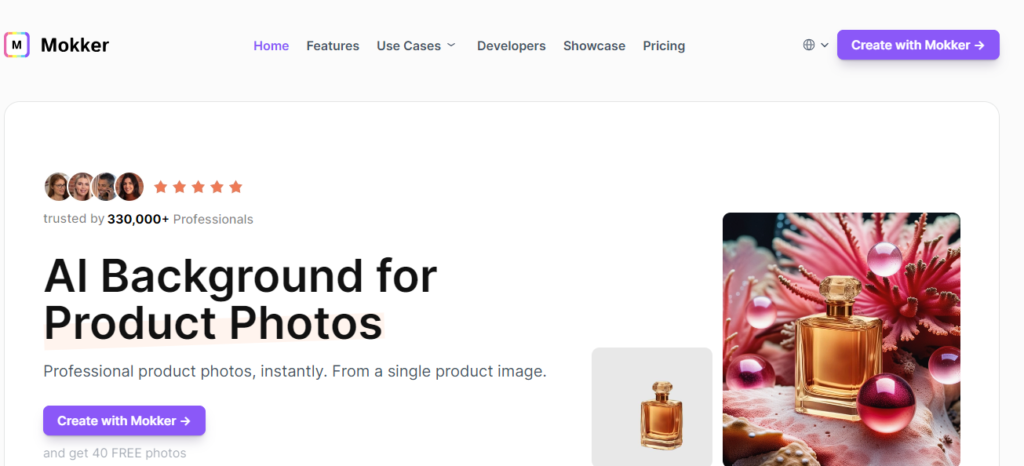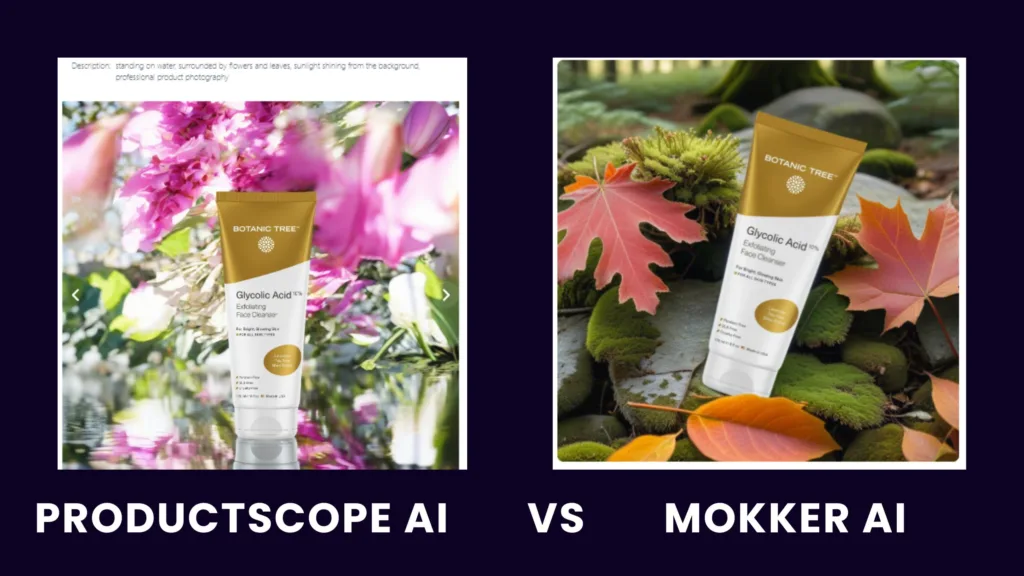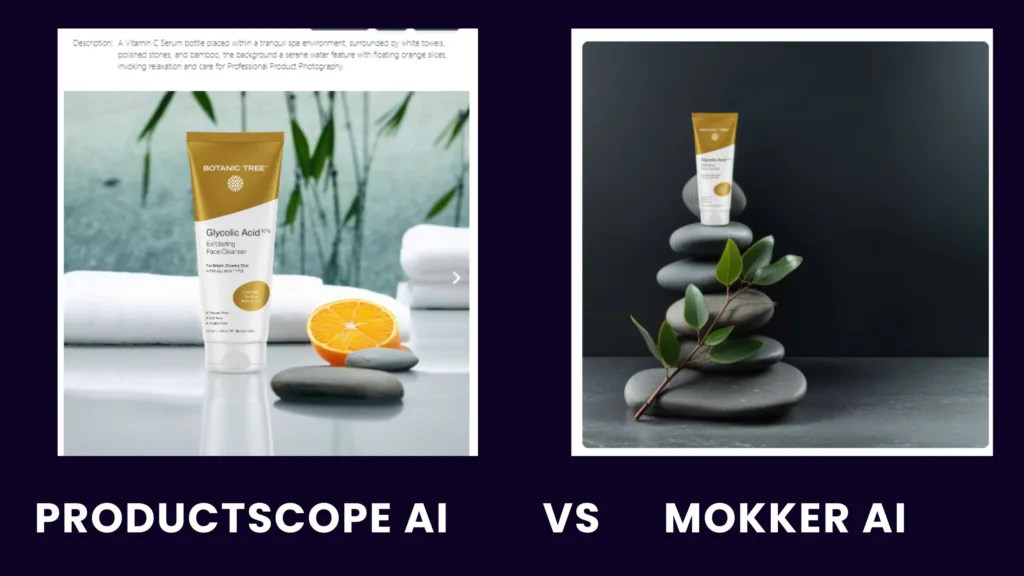Superior product imagery is vital for enhancing online retail sales and boosting e-commerce conversion rates. These images go beyond merely improving a brand’s image; they significantly contribute to raising the perceived worth of the products.
Nevertheless, excelling in product photography presents considerable challenges. It involves a hefty investment in both time and financial resources, typically costing about $200 per hour. It also necessitates a high level of skill in photography or proficiency in tools like Photoshop.
In light of these difficulties, a rising number of firms are shifting towards AI-enabled, automated methods for their product photography needs. This article aims to provide a comprehensive and neutral analysis of two AI-based tools: the AI Product Photo Generator by ProductScope AI and Mokker AI with a focus on their operational effectiveness and overall performance.
What Users Are Saying About Mokker AI: Real Feedback from the Product Hunt Community
Realistic Output That Impresses First-Time Users
Mokker AI has earned positive feedback for generating highly realistic product photos, even without the need for traditional photography. Users often highlight how surprised they are by the quality of AI-generated scenes, especially during their first try. The ease of achieving photo-realistic outputs makes it a favorite for non-designers.
- Produces convincing lifestyle imagery without real shoots
- Requires minimal user input to generate high-quality scenes
- Great first impression among new users, even without design experience
A Go-To Tool for Solo Entrepreneurs and Small Sellers
Many solo business owners use Mokker AI to quickly create promotional visuals without needing a photographer or studio. It’s particularly helpful for those managing Amazon or Etsy shops who want clean, styled images fast. The tool fills a major gap for budget-conscious sellers needing consistent visuals.
- Ideal for Amazon and Etsy listings
- Saves time and cost on professional photoshoots
- Perfect for solopreneurs and microbrands needing fast turnaround
Common Use Cases: From Product Photos to Ad Creatives
Mokker’s use cases go beyond just product photos—users are creating assets for websites, paid ads, packaging previews, and more. Its flexibility allows small businesses to generate multiple image styles with minimal effort. As a result, it supports both marketing and branding initiatives efficiently.
- Social media ads and website banners
- Product packaging previews
- Marketing visuals for online shops and stores
Limitations Noted by Some Users
While the reviews are mostly positive, some users mention that Mokker can occasionally produce inconsistent lighting or off-angle shadows. These issues are minor but may require rerunning a scene or manual editing. More complex scenes or niche product types may need additional setup to achieve the desired output.
- Slight lighting or shadow inconsistencies in certain outputs
- May require retries for complex product scenes
- Basic customization, not suited for detailed creative control
Mokker AI: A Comprehensive AI Photography Solution

Mokker AI takes a more generalist approach. It’s an all-encompassing solution for automated image editing, including background manipulation and enhancement features. While it may not offer the specialized Amazon-focused features of ProductScope AI, its versatility makes it suitable for a broader range of e-commerce platforms. Mokker AI is designed for businesses seeking a comprehensive tool for various aspects of product photography.
ProductScope AI: A Leader in AI-Powered Photography
ProductScope AI presents a cutting-edge approach to crafting product photography backgrounds using AI, specifically designed for Amazon businesses. This innovative service enables users to transform the appearance of their product photos, providing a vast array of photoshoot options. From a sunny breakfast setting to a snug reading corner, or even atop a mountain, ProductScope’s AI Photoshoot feature can realize these scenarios in high-quality imagery.
The primary benefit of this service lies in its affordability. Users can produce stunning images for a fraction of the cost of traditional photoshoots, potentially saving up to 99% without sacrificing quality. This AI-driven tool is only limited by the user’s creativity. They can simply input their desired product scene through AI prompts, and the system will generate the backdrop as specified.
Comparative Analysis: ProductScope AI vs Mokker AI

Feature-Rich and User-Centric
ProductScope AI provides a wide variety of photographic styles and settings, making it an excellent option for businesses aiming to differentiate themselves.
| Feature Aspect | ProductScope AI | Mokker AI |
|---|---|---|
| Core Functionality | AI-driven creation of imaginative and contextual product settings. | AI background replacement and template-based customization. |
| User Creativity | Highly encourages user creativity; limitless possibilities based on imagination. | Offers structured templates and editing features, less emphasis on user’s imaginative input. |
| Cost Efficiency | Extremely cost-effective, potentially 1/100th the cost of traditional methods. | Offers a free trial and various pricing plans, but less emphasis on cost-saving compared to ProductScope AI. |
| Quality of Output | High-quality images that are indistinguishable from professional photoshoots. | High-resolution, print-ready images suitable for various platforms. |
| Ease of Use | Simple user interface driven by AI prompts. | User-friendly, but involves a process of selecting and adjusting templates. |
| Customization | Unlimited customization based on user’s descriptive input. | Customization limited to available templates and specific editing features. |
| Versatility | Ideal for creating unique, context-rich images for each product. | More suited for standard product photography with enhanced backgrounds. |
| Innovative Approach | Pioneering in using AI to generate contextually rich product environments. | Focuses on improving existing product images rather than creating new contexts. |
Sign Up for ProductScope AI Today!
Intuitive User Experience
While both tools emphasize user experience, ProductScope AI stands out with its notably more user-friendly and accessible interface. This simplicity in use minimizes the learning curve, enabling businesses to concentrate on creative aspects instead of technical details.
| Criteria | ProductScope AI | Mokker AI |
|---|---|---|
| Ease of Interface | Highly intuitive for creative minds; simple AI prompt-based interface. | Structured step-by-step process; may feel less intuitive for users seeking creative freedom. |
| Creative Freedom | Excels in allowing imaginative input, offering a more personalized and engaging user experience. | Limited to predefined templates, offering less scope for creative expression. |
| User Engagement | Encourages active user participation in the creative process, enhancing engagement. | More passive user involvement, focused on selection rather than creation. |
| Learning Curve | Intuitive for users comfortable with descriptive language; minimal learning curve. | Requires familiarization with template selection and customization options. |
| Customization Level | Offers limitless customization driven by user’s imagination and descriptions. | Customization constrained within the bounds of available templates and features. |
| Narrative Approach | Ideal for users who prefer a narrative-driven process in creating product images. | Less narrative-focused, more about visually selecting and applying changes. |
| User Empowerment | Empowers users to be the primary creator of their product imagery, enhancing satisfaction. | Users rely on AI’s interpretation of selected templates, offering less personal control over the end result. |

Cost-Effectiveness
Regarding cost, ProductScope AI goes beyond offering just competitive prices. It delivers a substantial return on investment, bringing professional-grade photography within reach of even smaller e-commerce entities.
| Pricing Aspect | ProductScope AI | Mokker AI |
|---|---|---|
| Free Trial/Plan | 100 free images, no credit card required. | 40 free photos, full access to studio and templates. |
| Entry-Level Plan | Marketing Essentials Plan: $97/month for 1000 credits, comprehensive features across tools. | Starter Plan: $13/month for 500 photos, basic features. |
| Mid-Level Plan | Marketing PRO Plan: $197/month for 2400 credits, extensive features for larger needs. | Team Plan: $29/user/month, unlimited photos, suitable for small teams. |
| High-Level Plan | AGENCY Plan: Customized for big brands, includes full tool access and an Ad Audit. | Organization Plan: $83.25/user/month, for organizations, includes custom AI model. |
| Value for Money | Offers a more diverse range of tools and features at each pricing level, providing greater utility. | Focused mainly on photo editing, less diversity in tool offerings. |
| Flexibility | Tailored plans for different business sizes and needs, from individual users to large agencies. | Plans are more standardized, less tailored to specific business types or sizes. |
| Specialized Services | Includes unique services like Ad Audit in the AGENCY Plan, adding value beyond basic offerings. | Lacks additional services that complement the core offering. |
| Overall Cost-Effectiveness | Potentially more cost-effective for businesses needing a wide range of services. | More suitable for specific needs, primarily photo editing, with less emphasis on added services. |
How to Choose the Right AI Image Tool for Your Business: ProductScope AI VS Mokker AI

In today’s digital age, images play a crucial role in capturing the attention of customers and conveying messages effectively. With the advancements in artificial intelligence (AI), businesses now have access to powerful AI image tools that can enhance their visual content and streamline their workflows. However, with so many options available, it can be overwhelming to choose the right AI image tool for your business.
To help you make an informed decision, we have compiled a list of key factors to consider when selecting an AI image tool.
1. Define Your Needs and Goals
Before diving into the world of AI image tools, it’s essential to clearly define your needs and goals. Consider what specific tasks you want the tool to perform, such as image recognition, object detection, or image generation.
Assess your current workflow and identify areas where an AI image tool could improve efficiency or enhance the quality of your visual content. By understanding your requirements, you can narrow down your options and find a tool that aligns with your business objectives.
2. Evaluate Accuracy and Performance
One of the most critical factors to consider when choosing an AI image tool is its accuracy and performance. Look for tools that have a proven track record of delivering reliable results. Check for customer reviews and testimonials to gauge user satisfaction.
Additionally, consider the speed at which the tool processes images, as this can impact your workflow efficiency. A tool that combines high accuracy with fast processing times will ensure that you can rely on it for consistent and timely results.
3. Consider Integration Capabilities
To seamlessly incorporate an AI image tool into your existing workflow, it’s important to consider its integration capabilities. Look for tools that offer easy integration with popular platforms or software that you currently use, such as content management systems or graphic design software. This will save you time and effort in adapting your workflow to accommodate the new tool.
Additionally, check if the tool provides APIs or SDKs that allow for custom integrations, as this can further enhance its usability and flexibility.
4. Assess User-Friendliness and Ease of Use
Even the most powerful AI image tool won’t be beneficial if it’s difficult to use or requires extensive training. Assess the user-friendliness of the tool by exploring its interface and features. Look for intuitive controls, clear documentation, and accessible customer support.
A tool that is easy to navigate and understand will ensure that you and your team can quickly adapt to it and start leveraging its capabilities without significant learning curves.
5. Consider Pricing and Scalability
Pricing is an important consideration when choosing an AI image tool for your business. Evaluate the pricing structure of different tools and consider whether they offer a free trial or a freemium version to test their features before committing to a paid plan.
Additionally, assess the scalability of the tool. As your business grows, you may need to process a larger volume of images or require additional features. Ensure that the tool you choose can accommodate your future needs without significant cost increases or limitations.
Conclusion
Choosing between ProductScope AI and Mokker AI depends on specific business needs. ProductScope AI is ideal for Amazon sellers looking for tailored solutions and storytelling through images. Mokker AI suits businesses seeking a comprehensive tool for diverse e-commerce platforms. Both tools signify a leap forward in the realm of AI-driven product photography, promising a future where visual presentation is limited only by imagination.
Transform your Amazon business with ProductScope AI’s innovative AI-powered product photography Photoshoot. Visualize your product in any setting, from a sunny breakfast spot to a serene reading corner or an adventurous mountain peak. Our AI Photoshoot tool turns your ideas into beautiful, high-quality images at a minimal cost. Experience the difference in creativity and cost-effectiveness. Discover the magic of ProductScope AI now!
Sign Up for ProductScope AI Today!
FAQs
How adaptable are these tools to market trends?
Both ProductScope AI and Mokker AI are designed to evolve with market trends, incorporating the latest in AI technology.
Which is better for small businesses?
ProductScope AI is more cost-effective for small Amazon sellers, while Mokker AI offers flexible solutions for various business sizes.
What are their unique selling points?
ProductScope AI’s unique selling point is its Amazon-focused customization, while Mokker AI offers a comprehensive suite of image editing tools suitable for a wide range of e-commerce platforms.

